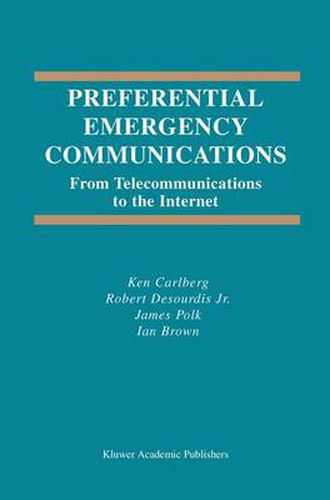Readings Newsletter
Become a Readings Member to make your shopping experience even easier.
Sign in or sign up for free!
You’re not far away from qualifying for FREE standard shipping within Australia
You’ve qualified for FREE standard shipping within Australia
The cart is loading…






This title is printed to order. This book may have been self-published. If so, we cannot guarantee the quality of the content. In the main most books will have gone through the editing process however some may not. We therefore suggest that you be aware of this before ordering this book. If in doubt check either the author or publisher’s details as we are unable to accept any returns unless they are faulty. Please contact us if you have any questions.
With the tragic airline disaster in New York City, on September 11th, 2001, the subject of emergency communications has become very important. This work is intended to provide an in-depth exposure to authorized emergency communications. These communications generally involve preferential treatment of signalling and/or data to help ensure forwarding of information through a network. This book covers examples ranging from private networks to current investigations using Next Generation Networks (IP based communications). The information acts as a reference for network designers, network vendors, and users of authorized emergency communications services. The book is divided into three sections. The first describes systems and protocols that have been deployed as private networks for use by government agencies like the US Department of Defense. This section also presents an in-depth discussion on MLPP. We then present current work in the area of Land Mobile Radio, commonly used by local emergency personnel such as police and firemen. This second section also describes systems that have been deployed over the public switched telephone network. Finally, the third section presents insights on trying to support emergency communications over TCP/IP networks and the Internet. In this last item we look into what IETF protocols can be considered candidates for change, as well as those protocols and applications that should not be altered.
$9.00 standard shipping within Australia
FREE standard shipping within Australia for orders over $100.00
Express & International shipping calculated at checkout
This title is printed to order. This book may have been self-published. If so, we cannot guarantee the quality of the content. In the main most books will have gone through the editing process however some may not. We therefore suggest that you be aware of this before ordering this book. If in doubt check either the author or publisher’s details as we are unable to accept any returns unless they are faulty. Please contact us if you have any questions.
With the tragic airline disaster in New York City, on September 11th, 2001, the subject of emergency communications has become very important. This work is intended to provide an in-depth exposure to authorized emergency communications. These communications generally involve preferential treatment of signalling and/or data to help ensure forwarding of information through a network. This book covers examples ranging from private networks to current investigations using Next Generation Networks (IP based communications). The information acts as a reference for network designers, network vendors, and users of authorized emergency communications services. The book is divided into three sections. The first describes systems and protocols that have been deployed as private networks for use by government agencies like the US Department of Defense. This section also presents an in-depth discussion on MLPP. We then present current work in the area of Land Mobile Radio, commonly used by local emergency personnel such as police and firemen. This second section also describes systems that have been deployed over the public switched telephone network. Finally, the third section presents insights on trying to support emergency communications over TCP/IP networks and the Internet. In this last item we look into what IETF protocols can be considered candidates for change, as well as those protocols and applications that should not be altered.